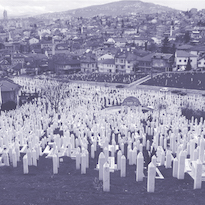A Battle of Memory and Image: War Tourism as Reconstruction Strategy in Sarajevo
Abstract
Sarajevo, known as ‘the Jerusalem of Europe’, is one of the most attractive tourist destinations in the Balkan region. Its geo-political position, tremendous landscape and rich historical and cultural heritage including architectural portrayals of different eras turns the city into an authentic, vibrant place of living. Alongside, the 1990s’ Bosnian War left heavy traces in the urban landscape and signs of the conflict are clearly traceable in today’s city. The city has managed to recover slowly since the war ended in 1995, but the urban fabric seems to be avoided as more than just a physical occurrence during the implementation of post-war reconstruction applications. In this scope, the main objective of this chapter is to examine the process and outcomes of the post-war tourism industry in spatial, cultural, socio-political and economical manner in the case of Sarajevo. The study investigates the representation of war as a tourist attraction, evaluating the physical expressions of belonging in the city and how this is reflected in today’s narratives. The research is based on a comparative historical urban analysis to illustrate the impact of war tourism in the city and 11 in-depth interviews to narrate the related personal and collective memories. Results show that the new post-war physical (reconstruction strategy policies) and social (citizens’ perception) layer integrated in the existing townscape emboldens the vision of war tourism.
Downloads

Downloads
Published
How to Cite
Issue
Section
License
Copyright (c) 2023 Tülay Zıvalı

This work is licensed under a Creative Commons Attribution 4.0 International License.
The authors keep their rights upon their work, although they transfer, in a non-exclusive way, the rights of exploitation (reproduction, publication, distribution, public dissemination and presentation) to the Journal. The authors are, therefore, free to enter additional, separate contracts for the non-exclusive distribution of the version of the work published in the Journal (for instance, by hosting in an institutional repository or publication in a book), provided credit is given that the work was initially published in this journal. The works are published under a Creative Commons Attribution 4.0 (CC BY 4.0) license.











